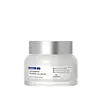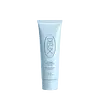What's inside
What's inside
 Key Ingredients
Key Ingredients

 Benefits
Benefits

 Concerns
Concerns

 Ingredients Side-by-side
Ingredients Side-by-side

Niacinamide 2%
SmoothingAdenosine 0.04%
Skin ConditioningWater
Skin ConditioningButylene Glycol
HumectantGlycerin
Humectant1,2-Hexanediol
Skin ConditioningDipropylene Glycol
HumectantCetearyl Alcohol
EmollientSodium Polyacryloyldimethyl Taurate
Emulsion StabilisingCarbomer
Emulsion StabilisingArginine
MaskingHydrogenated Lecithin
EmulsifyingAllantoin
Skin ConditioningZea Mays Starch
AbsorbentMicrocrystalline Cellulose
AbsorbentMannitol
HumectantCentella Asiatica Extract
CleansingFicus Carica Fruit Extract
HumectantEthylhexylglycerin
Skin ConditioningCeramide NP
Skin ConditioningPhytosterols
Skin ConditioningDisodium EDTA
Palmitic Acid
EmollientStearic Acid
CleansingMyristic Acid
CleansingHyaluronic Acid
HumectantPentylene Glycol
Skin ConditioningDioscorea Japonica Root Extract
Skin ConditioningLaminaria Japonica Extract
Skin ProtectingViola Mandshurica Flower Extract
AntioxidantUlmus Davidiana Root Extract
Skin ConditioningAloe Barbadensis Leaf Extract
EmollientCaprylyl Glycol
EmollientLactobacillus Ferment
Skin ConditioningNiacinamide 2%, Adenosine 0.04%, Water, Butylene Glycol, Glycerin, 1,2-Hexanediol, Dipropylene Glycol, Cetearyl Alcohol, Sodium Polyacryloyldimethyl Taurate, Carbomer, Arginine, Hydrogenated Lecithin, Allantoin, Zea Mays Starch, Microcrystalline Cellulose, Mannitol, Centella Asiatica Extract, Ficus Carica Fruit Extract, Ethylhexylglycerin, Ceramide NP, Phytosterols, Disodium EDTA, Palmitic Acid, Stearic Acid, Myristic Acid, Hyaluronic Acid, Pentylene Glycol, Dioscorea Japonica Root Extract, Laminaria Japonica Extract, Viola Mandshurica Flower Extract, Ulmus Davidiana Root Extract, Aloe Barbadensis Leaf Extract, Caprylyl Glycol, Lactobacillus Ferment
Water
Skin ConditioningGlycerin
HumectantDimethicone
EmollientDimethicone Crosspolymer
Emulsion StabilisingC12-15 Alkyl Benzoate
AntimicrobialHydroxyethyl Acrylate/Sodium Acryloyldimethyl Taurate Copolymer
Emulsion StabilisingImperata Cylindrica Root Extract
Skin ConditioningCaprylic/Capric Triglyceride
MaskingMethylpropanediol
SolventSqualane
EmollientCetyl Alcohol
EmollientMeadowfoam Estolide
Skin ConditioningDipalmitoyl Hydroxyproline
Skin ConditioningTribehenin
EmollientSodium PCA
HumectantUrea
BufferingCarbomer
Emulsion StabilisingPhenoxyethanol
PreservativeCaprylyl Glycol
EmollientCollagen Amino Acids
MoisturisingPropanediol
SolventHaematococcus Pluvialis Extract
AntioxidantTrehalose
HumectantLinoleic Acid
CleansingPhytosterols
Skin ConditioningPhospholipids
Skin ConditioningPalmitic Acid
EmollientPolysorbate 60
EmulsifyingSorbitan Isostearate
EmulsifyingCeramide Ng
Skin ConditioningHexylene Glycol
EmulsifyingPEG-10 Phytosterol
EmulsifyingPolyquaternium-51
Skin ConditioningTriacetin
AntimicrobialSodium Hyaluronate
HumectantAcrylates/C10-30 Alkyl Acrylate Crosspolymer
Emulsion StabilisingPalmitoyl Hexapeptide-12
Skin ConditioningSodium Hydroxide
BufferingLactic Acid
BufferingWater, Glycerin, Dimethicone, Dimethicone Crosspolymer, C12-15 Alkyl Benzoate, Hydroxyethyl Acrylate/Sodium Acryloyldimethyl Taurate Copolymer, Imperata Cylindrica Root Extract, Caprylic/Capric Triglyceride, Methylpropanediol, Squalane, Cetyl Alcohol, Meadowfoam Estolide, Dipalmitoyl Hydroxyproline, Tribehenin, Sodium PCA, Urea, Carbomer, Phenoxyethanol, Caprylyl Glycol, Collagen Amino Acids, Propanediol, Haematococcus Pluvialis Extract, Trehalose, Linoleic Acid, Phytosterols, Phospholipids, Palmitic Acid, Polysorbate 60, Sorbitan Isostearate, Ceramide Ng, Hexylene Glycol, PEG-10 Phytosterol, Polyquaternium-51, Triacetin, Sodium Hyaluronate, Acrylates/C10-30 Alkyl Acrylate Crosspolymer, Palmitoyl Hexapeptide-12, Sodium Hydroxide, Lactic Acid
 Reviews
Reviews

Ingredients Explained
These ingredients are found in both products.
Ingredients higher up in an ingredient list are typically present in a larger amount.
Caprylyl Glycol is a humectant and emollient, meaning it attracts and preserves moisture.
It is a common ingredient in many products, especially those designed to hydrate skin. The primary benefits are retaining moisture, skin softening, and promoting a healthy skin barrier.
Though Caprylyl Glycol is an alcohol derived from fatty acids, it is not the kind that can dry out skin.
This ingredient is also used as a preservative to extend the life of products. It has slight antimicrobial properties.
Learn more about Caprylyl GlycolCarbomer is a polymer of acrylic acid. Its main role is to create a gel consistency.
A high amount of carbomer can cause pilling or balling up of products. Don't worry, most products contain 1% or less of carbomer.
Glycerin is already naturally found in your skin. It helps moisturize and protect your skin.
A study from 2016 found glycerin to be more effective as a humectant than AHAs and hyaluronic acid.
As a humectant, it helps the skin stay hydrated by pulling moisture to your skin. The low molecular weight of glycerin allows it to pull moisture into the deeper layers of your skin.
Hydrated skin improves your skin barrier; Your skin barrier helps protect against irritants and bacteria.
Glycerin has also been found to have antimicrobial and antiviral properties. Due to these properties, glycerin is often used in wound and burn treatments.
In cosmetics, glycerin is usually derived from plants such as soybean or palm. However, it can also be sourced from animals, such as tallow or animal fat.
This ingredient is organic, colorless, odorless, and non-toxic.
Glycerin is the name for this ingredient in American English. British English uses Glycerol/Glycerine.
Learn more about GlycerinPalmitic Acid is a fatty acid naturally found in our skin and in many plant and animal sources. In cosmetics, it is usually derived from palm oil. It serves many purposes in skincare, acting as a cleanser, emollient, and emulsifier.
As an emollient, palmitic acid helps soften and smooth the skin by preventing water loss. In cleansers, it helps remove oil and dirt while creating foam.
Its emulsifying properties help stabilize products by keeping water and oil-based ingredients from separating.
This may not be suitable for fungal acne-prone skin, as fatty acids like this can sometimes trigger breakouts in sensitive individuals.
Learn more about Palmitic AcidPhytosterols come from plants, nuts, and whole grains. These compounds have skin soothing and moisturizing properties.
Fun fact: They are similar to cholesterol and can help lower cholesterol levels.
Water. It's the most common cosmetic ingredient of all. You'll usually see it at the top of ingredient lists, meaning that it makes up the largest part of the product.
So why is it so popular? Water most often acts as a solvent - this means that it helps dissolve other ingredients into the formulation.
You'll also recognize water as that liquid we all need to stay alive. If you see this, drink a glass of water. Stay hydrated!
Learn more about Water